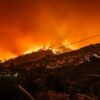Thirty years ago, on the flanks of a volcano in California’s Sierra Nevada range, trees began to die en masse, suffocated at their roots by carbon dioxide seeping up from the mountain’s depths after a swarm of small earthquakes.
The wave of tree deaths on Mammoth Mountain, which lies within one of the nation’s largest active volcanic systems, prompted scientists to start monitoring the volcano’s emissions more closely.
Now, researchers led by Stanford University geologist George Hilley have made a surprising discovery in the long-running record: The ebb and flow of carbon dioxide emissions from Mammoth Mountain are strongly linked to the weight of snow and ice atop the Sierra Nevada, and to the amount of water that percolates from ground level down into the volcano’s plumbing.
“This really shows how the solid Earth is coupled to climate and the things that go on at the surface,” said Hilley, professor of geological sciences in Stanford’s School of Earth, Energy & Environmental Sciences (Stanford Earth). “Droughts can change the way in which volcanoes breathe.”
The research, published March 9 in Geophysical Research Letters, comes amid a dry winter that has left California snowpack well below average for this time of year, with less than a week remaining in the state’s wet season and no major snowstorms in the forecast.
By the end of this century, state officials predict the Sierra Nevada snowpack will decline by 48 to 65 percent from the historical April 1 average. “Changes in Earth’s hydrology due to climate change could actually impact something like the tempo at which gases are emitted from volcanic systems,” Hilley said.
Horseshoe Lake
Hilley and coauthors analyzed measurements of carbon dioxide emissions taken every 30 minutes for six years from Horseshoe Lake, the best-studied tree kill area on Mammoth Mountain. The mountain rises along the southwest rim of Long Valley Caldera, a crater formed by a supervolcano eruption 760,000 years ago.
The results reveal a persistent 20 percent reduction in the amount of carbon dioxide seeping up from the ground during the spring of 2017. The downshift coincides with the region’s emergence from intense drought and the pileup of the biggest Sierra Nevada snowpack in decades.
The study builds upon research by USGS volcanologist Jennifer Lewicki showing that carbon dioxide emissions in the Horseshoe Lake tree-kill area changed seasonally and across multiple years for reasons unrelated to a brewing eruption.
Seeking an explanation for these variations, Lewicki and Hilley—with coauthor Curtis Baden of Stanford—developed mathematical models to test out plausible mechanisms. Snowmelt and rainfall can wash away carbon dioxide that might otherwise seep from the ground, for example. But their calculations show Mammoth Mountain receives far too little precipitation to account for the low springtime CO2 levels observed in 2017.
The most likely explanation for the seasonal changes in Mammoth Mountain’s carbon dioxide emissions has to do with an underground crack, or fault, which to a trained eye is evident in the vegetation patterns and topography of the landscape. Changes in the distribution of stress across the whole mountain range seem to open and close the fault like a valve, or like the tiny gaps between old floorboards that flex under shifting weight.
Using GPS data and snow depth measurements, the authors found compressive force on the fault between 2014 and 2020 generally peaked in winter as snowpack accumulated across the Sierra Nevada and eased during snow-free summer months. Carbon dioxide emission levels dipped during periods when the weight of snow and water in the mountains flexed Earth’s crust, squeezing together the rocks on either side of the Mammoth Mountain fault.
One limitation of the study is that it does not provide a physics-based model of the fault’s movement and how gas flows through it. “We’re using stress changes as proxies for the opening and closing of a conduit,” Hilley said. “An interesting study would run a three-dimensional model of gas transport through a conduit that you could actually open and close, and then run that model many times to see if its predictions quantitatively match the carbon dioxide measurements we’re making.”
Predicting future eruptions
The ability to distinguish between CO2 fluctuations driven by climate from those driven by an impending eruption will enable better hazard forecasts, which are based partly on signs that rising magma is triggering earthquakes, deforming the ground surface or ushering gases upward. “The alignment of all three of those is generally a clue that an eruption might be about to happen,” Hilley said.
For decades, ground deformation and seismicity around some of the United States’ active volcanoes have been monitored continuously using GPS and satellites, and scientists can view the data in close to real time. But they have a murkier view on volcanic gas. “In the past, at most volcanoes, scientists had to go into a volcanic area in advance of an eruption, or even between eruptions, and go collect this gas for later analysis. It’s real Indiana Jones-type stuff,” said Hilley.
The difficulty of collecting volcanic gases has resulted in limited records, sometimes with only a single snapshot of a volcano’s degassing in any given year, which makes it challenging to detect changes that may warn of an eruption—or to understand patterns linked to Earth’s climate system.
The new study offers a glimpse of insights to come as scientists gain access to more volcanic emission data, thanks in part to the development of less expensive and more durable instruments.
“The hope is, in the next couple years, we can have a record of what the gas is doing in near real time,” Hilley said. “When you look in detail, you can see there are seasonal fluctuations that probably have nothing to do with the actual volcanic state.”
More information:
George E. Hilley et al, Seasonal and Multiyear Changes in CO 2 Degassing at Mammoth Mountain Explained by Solid‐Earth‐Driven Fault Valving, Geophysical Research Letters (2022). DOI: 10.1029/2021GL096595
Provided by
Stanford University
Citation:
Research finds drought alters Mammoth Mountain’s carbon dioxide emissions (2022, March 30)



